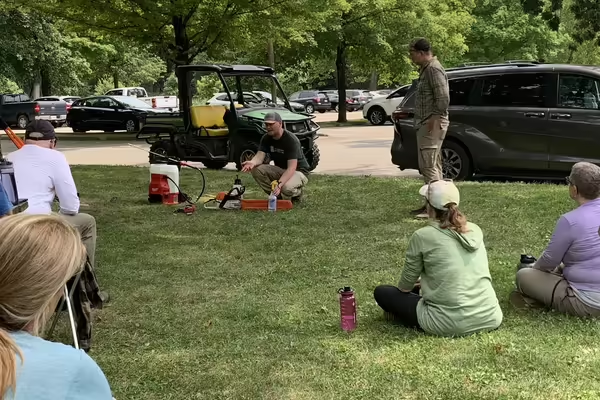
URBANA, Ill. — When is the best time to remove invasive amur bush honeysuckle? Is it better to mow an invasion of teasel or treat it with an herbicide? What is the best way to get rid of tree of heaven?
Answers to these questions and more were covered by University of Illinois Extension this fall at the first statewide Introduction to Invasive Species Management course. When it comes to invasive species, a one-size-fits-all approach does not work, so experience is often the best teacher. In August, 145 volunteers and land and homeowners took an innovative online and in-person course giving them access to expert recommendations and hands-on experience.
One out of three plants in Illinois woodlands, wetlands, and grasslands are non-native, causing many environmental and economic impacts because they spread quickly and are hard to remove once established. The online learning day covered problematic invasive species in Illinois, different ecosystems, plant identification, and control techniques.
“The online learning day presented a lot of great information on invasive species that serves as baseline knowledge for anyone starting to work with invasive species,” said Christopher Evans, forestry Extension and research specialist, and the program coordinator. “However, invasive species identification and management are both hard to grasp just from seeing presentation slides alone.”
Local Extension educators offered six regional field days in Warrenville, Carlock, Quincy, Monticello, Taylorville, and Murphysboro, giving participants the unique opportunity to apply their new skills with invasive species in their area.
Horticulture Educator Jamie Viebach led the Warrensville field day, where their group found tree of heaven, a rapidly growing deciduous tree, on a local preserve, which she had never seen in person before.
“I was hoping participants would get experience recognizing what invasive species are here and begin seeing them in their surroundings," Viebach said. “I was pleasantly surprised at how eager everyone was to learn. It was like playing ‘stump the interpreter' with plant identification on our walk around the preserve.”
Most of those who joined the program to learn more about invasives have already had experiences with these challenges and left with new skills for managing invasive species.
“You could tell all the participants had a story about an invasive or two and that they had struggled with the fight,” said natural resources, environment and energy educator Karla Griesbaum, who led the Monticello field day.
Across the state, Illinois Extension staff and volunteers work with communities to identify potential invasions, remove invasive species, and restore natural areas. And to answer the opening questions, bush honeysuckle can be treated in spring or fall, it just depends on your goals and the property. Teasel can be best treated with prescribed fire and herbicide. And with its suckering roots, tree of heaven infestations can quickly spread, so chemical treatment is the best option. Explore more about invasive species in Illinois and how to manage them at go.illinois.edu/Invasive.
To connect with Extension natural resources, environment, and energy staff about a program or for a consultation, visit go.illinois.edu/NREEstaff. Extension’s natural resources, environment, and energy program provides research-based education for awareness and action to sustain healthy environments and ecosystems that support quality living and resilient communities. Extension staff empower people across Illinois to make a difference through the Master Naturalist, Climate Steward, and Watershed Steward volunteer and training programs.
Photo: The invasive species field day at Allerton Park in Monticello. By Karla Griesbaum.
University of Illinois Extension develops educational programs, extends knowledge, and builds partnerships to support people, communities, and their environments as part of the state's land-grant institution. Extension serves as the leading public outreach effort for University of Illinois Urbana-Champaign and the College of Agricultural, Consumer and Environmental Sciences in all 102 Illinois counties through a network of 27 multi-county units and over 700 staff statewide. Extension’s mission is responsive to eight strategic priorities — community, economy, environment, food and agriculture, health, partnerships, technology and discovery, and workforce excellence — that are served through six program areas — 4-H youth development, agriculture and agribusiness, community and economic development, family and consumer science, integrated health disparities, and natural resources, environment, and energy.